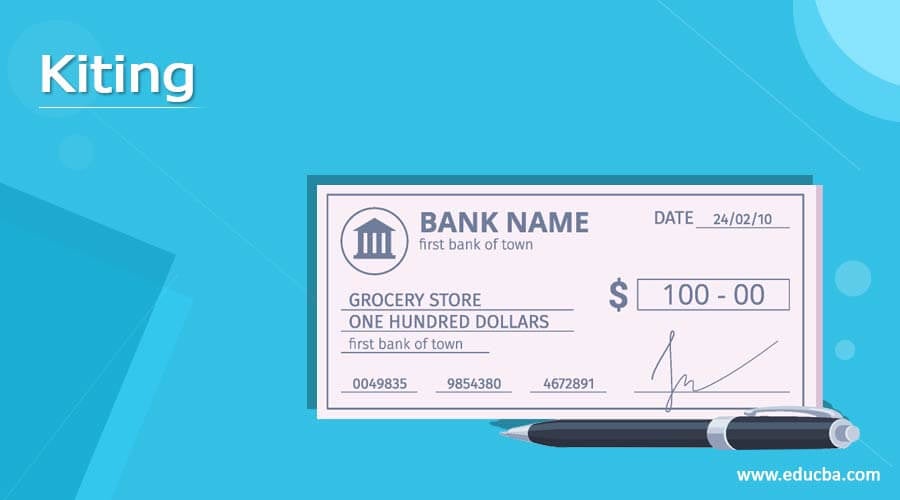Updated July 12, 2023
What is Kiting?
The term “kiting” refers to a type of financial fraud that involves taking advantage of the time difference between a cheque submission and its clearance. In this scam, the cheat executes multiple transactions using a checking or other bank account that has no real funds. In this manner, individuals exploit a valid financial instrument by utilizing it as unauthorized credit.
It can be categorized into two major types of fraud:
- Issuance or alteration of cheque or bank draft without sufficient fund
- Misrepresentation of financial instrument’s value for enhancing financial leverage or extending credit limit
In the 1920s, people began using the term “kiting” to actively describe the practice of issuing IOUs and bonds without providing any collateral as a basis of support. This action of issuing financial instruments without underlying backing became commonly referred to as “flying a kite.”
How Does Kiting Work?
Typically, the fraudsters involved in kiting scams deeply understand the timing delay between cheque submission and clearance. Therefore, they take advantage of this timing delay to withdraw cash (either partially or entirely) from a non-existent fund before the bank discovers the scam.
A typical kiting scam can be broken down into the following stages:
- First, a person with multiple accounts across different banks writes a cheque on day T-1 to himself from Bank 1 to Bank 2. So, funds become available in Bank 2, sufficient for all its payment obligations.
- On the next business day, the person writes another cheque in Bank 2 to himself and deposits it in Bank 1. This leads to the creation of artificial funds in Bank 1, enabling the comfortable clearance of the check written on T-1.
- This cycle reiterates until the offender gets apprehended or can deposit funds, eliminating the need for the kite. A kiting scam operates by executing intricate and obscure transactions that evade detection.
Examples of Kiting
Now, let us have a look at some of the examples to understand them in detail.
Example #1
Let us take the case of David, who has multiple bank accounts in his name. He wrote himself a cheque for $1,000 from his checking account in Bank A and deposited it in another checking account in Bank B on Monday. However, the balance in Bank A is only $100. So, he promptly (before clearance of the previous cheque) withdrew the $1,000 from Bank B and deposited it in Bank A on Tuesday, which means that now Bank A has sufficient funds to honor the cheque written on Monday. The virtual fund perpetually cycles this way until the financial crunch is resolved or the scam is exposed. This is a classic example of cheque kiting in which the fraudster uses non-existent funds.
Example #2
Let us take the case of John, who is selling his car piano on a used car-selling website. A scammer confirmed to John that he liked the car and intends to purchase it for $20,000. After completing the deal, the scammer called up John and told him that “mistakenly” he wrote the check for $25,000, an amount greater than the quoted price. So, the scammer asked John to wire back the difference of $5,000, and John did accordingly. Later, John discovered that the scammer had absconded with the car, and the check had been returned due to insufficient funds. In this case, John became the victim of a kiting scam.
Importance of Kiting
Kiting is illegal in many countries as it involves exploiting the float system prevalent in some banking systems. Scammers utilize this float to engage in illegal transactions using negotiable instruments such as cheques before the funds are actually available in the account. By doing so, they effectively convert the instrument into a type of short-term credit without genuine financial backing.
The financial consequences of a well-executed kiting scam can be substantial, potentially resulting in multimillion-dollar losses depending on the size of the targeted institution. Therefore, it is crucial to proactively identify kiting transactions before they escalate into significant financial crises.
How to Prevent Kiting?
In order to prevent kiting scams, one needs to vigilantly monitor the following –
- Customers engage in deposit and withdrawal activities to disguise or hide their actual negative account balances.
- Cheques are commonly used to clear overdrafts instead of cash.
- The total dollar value of debits and credits is the equal
- Very frequent account balance inquiries from the account holder
- A cheque of large dollar value is being drawn on the same payee bank
Key Takeaways
Some of the key takeaways of the article are:
- Kiting refers to the illegal usage of financial instruments to deceptively obtain enhanced credit limits and better financial leverage.
- The kiters take advantage of the timing difference between the submission and clearance of the cheques.
- Typically, a kiting scam involves many complex and convoluted transactions that reiterate themselves until the offender stops.
- The financial transactions should be monitored closely and minutely to prevent kiting scams.
Conclusion
Kiting resorts to the misuse of financial instruments, which is why it is a criminal offense in many countries. The implications of kiting can be serious, and hence it is important to prevent its occurrence. However, the good news is that many checks can be used to identify and prevent kiting transactions. So, although kiting is a threat with serious repercussions, the available monitoring mechanisms can help avoid the risk.
Recommended Articles
This is a guide to Kiting. Here we also discuss the definitions, their working, examples, importance, and key takeaways of Kiting. You may also have a look at the following articles to learn more –



